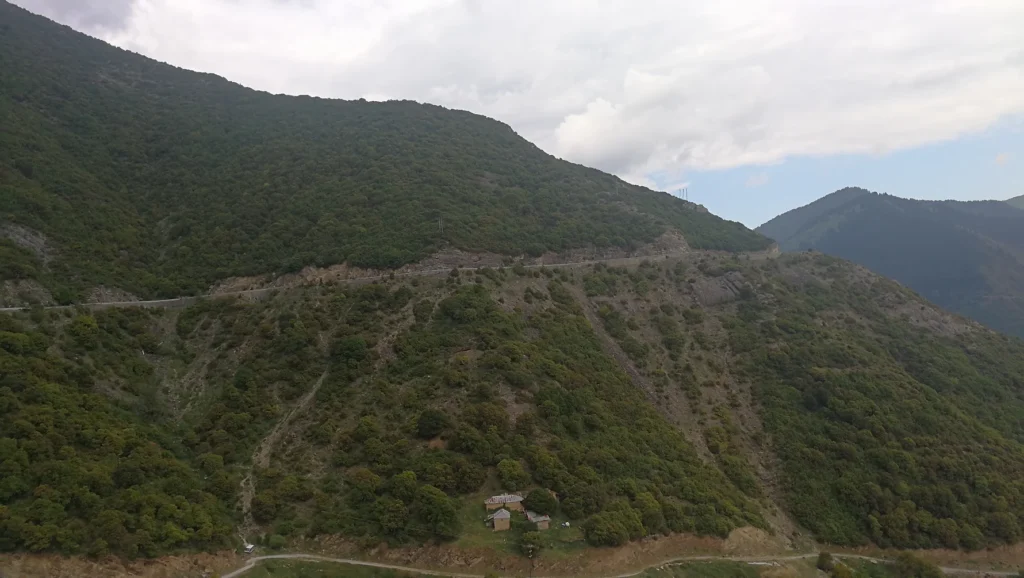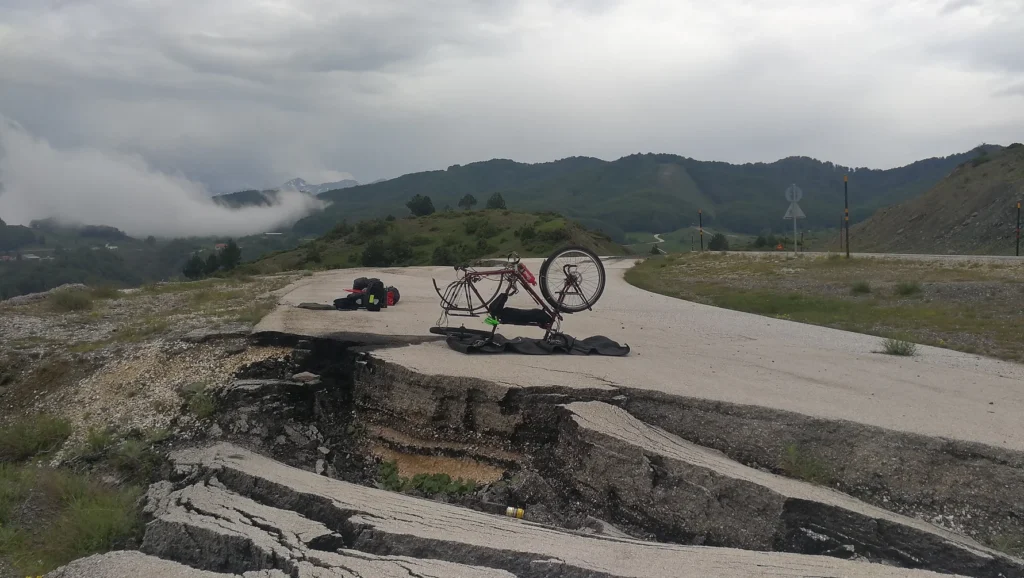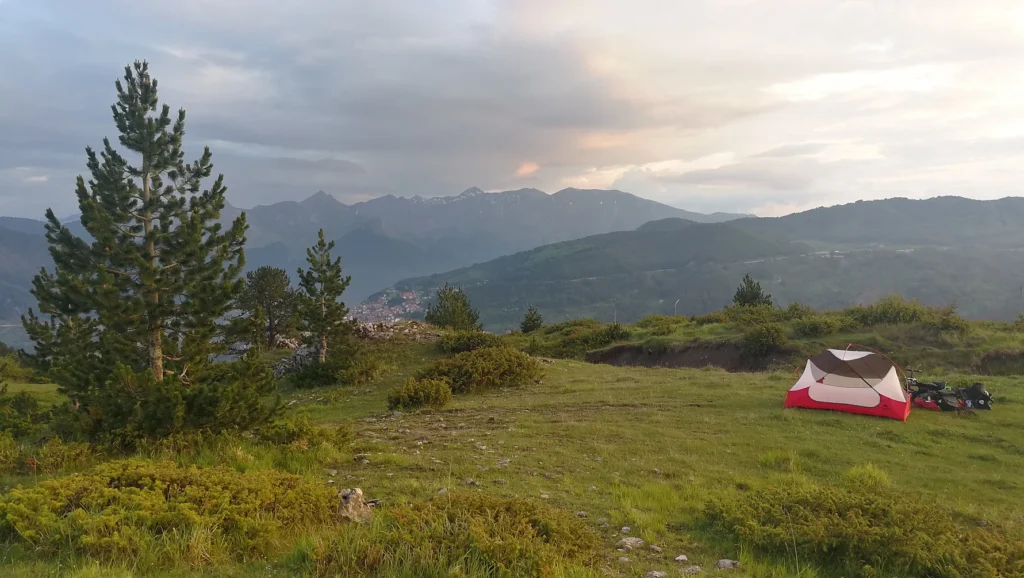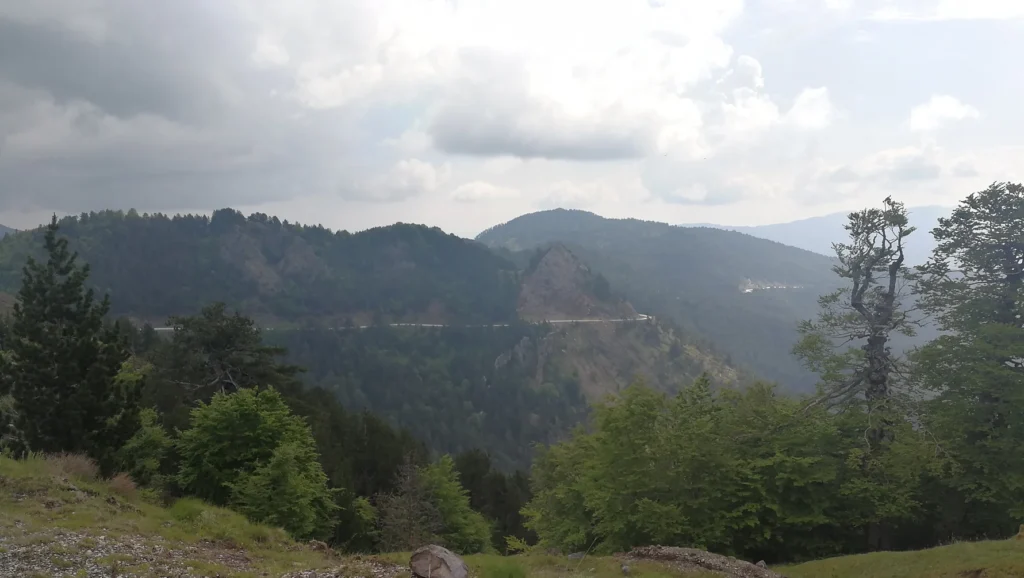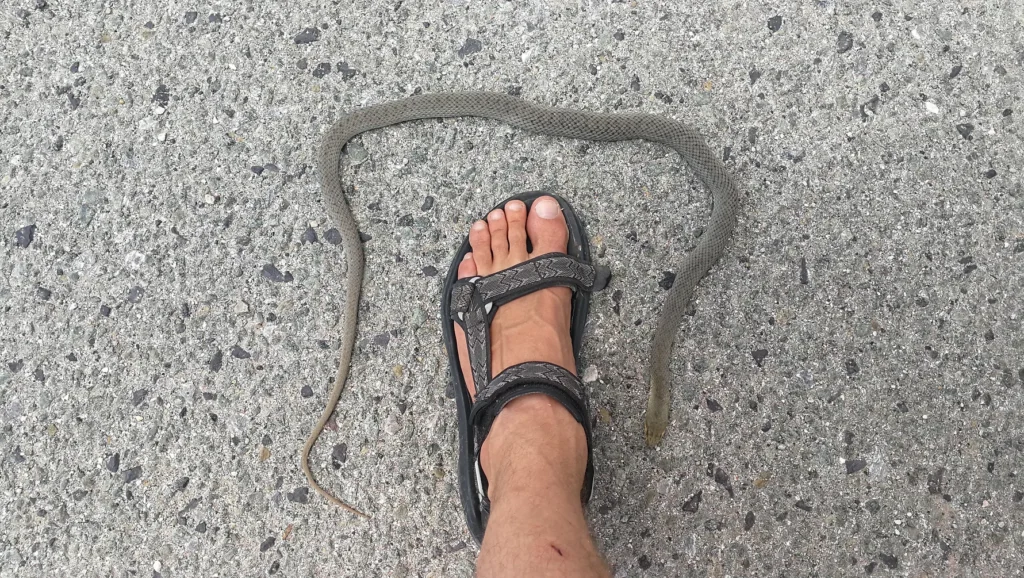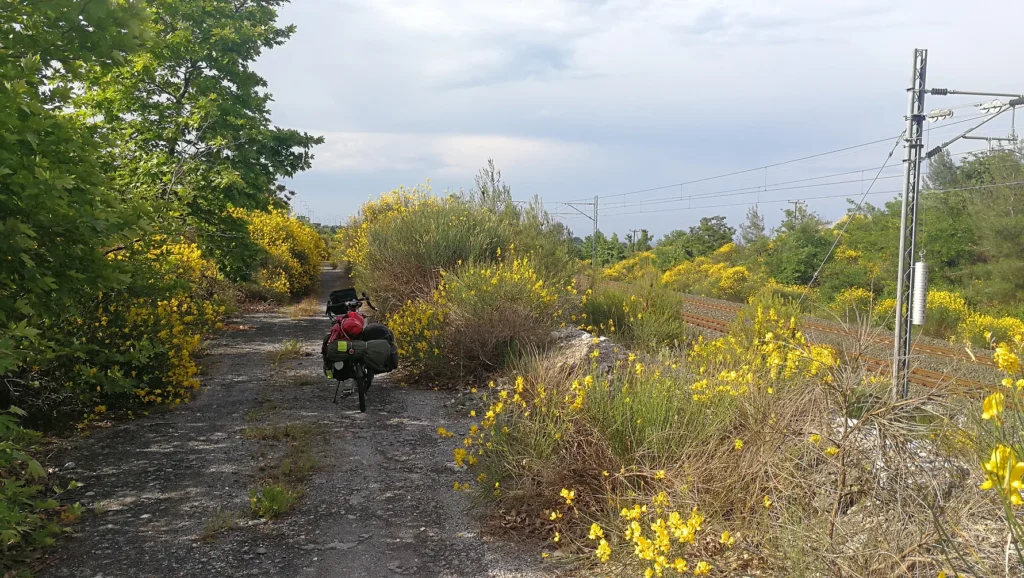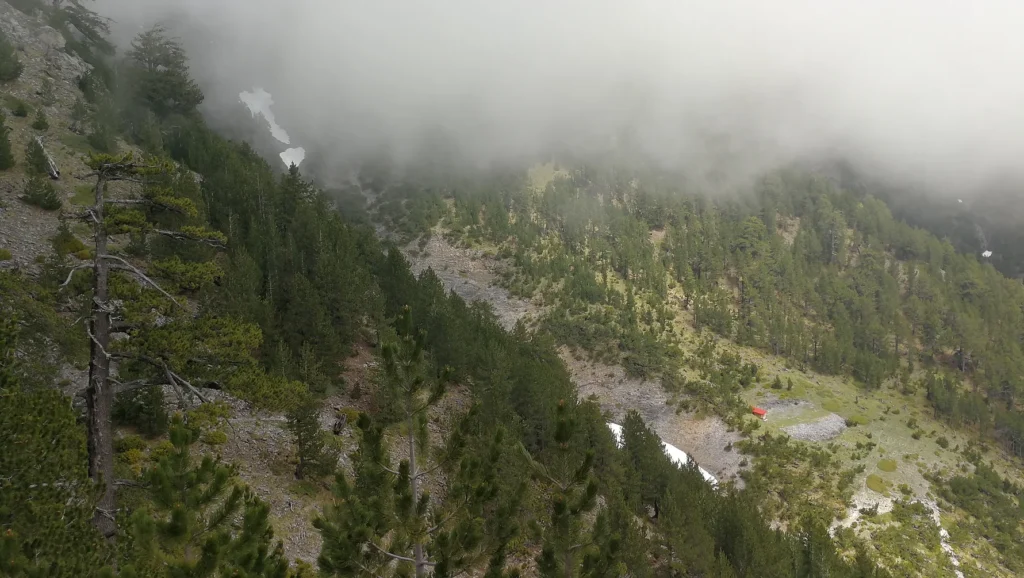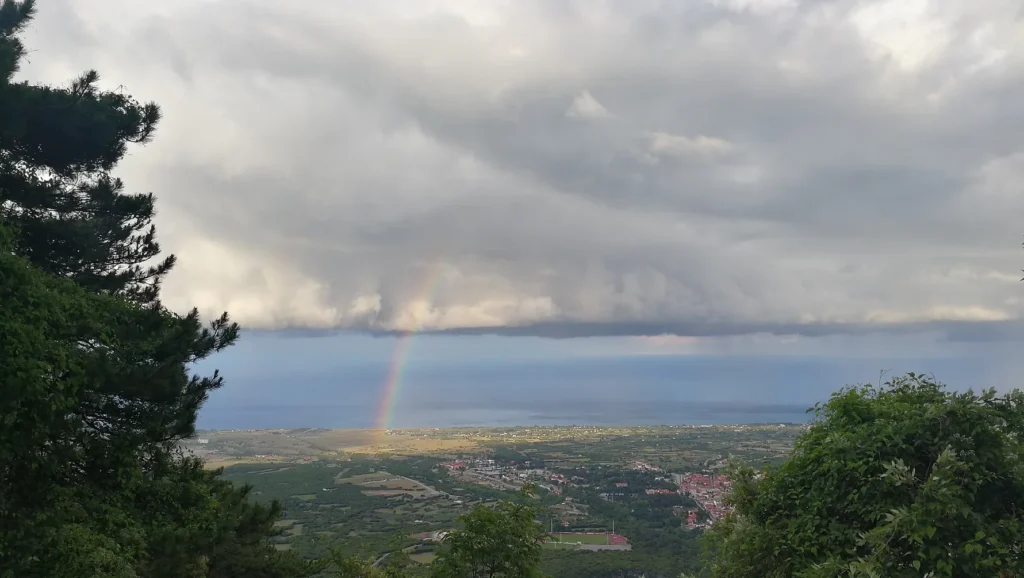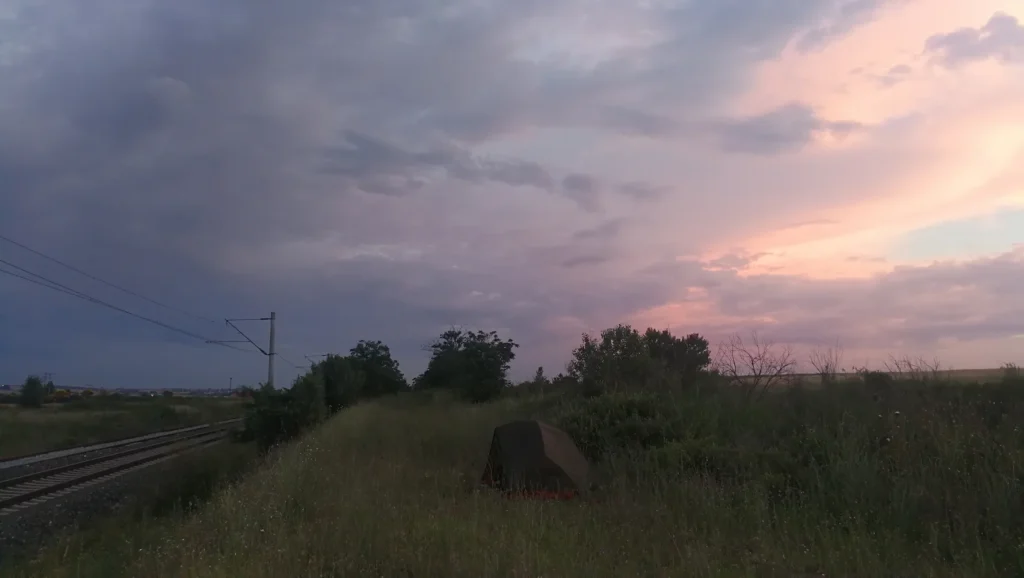Greece — Meditation
In the morning I reached the Albania-Greece border at Kakavijë. Pretty relaxed border crossing – I bought the last Albanian mountain tea (a dried yellow flower) while standing at the passport control booth.
After the border I cycled a long downhill through what felt like an extended no-mans-land. Weird area with roadkill rotting away in the heat. I stopped twice to help turtles over the curbstone.
10 km after the border the first sign of civilization was a World War II memorial in the form of a fighter jet.
25 km after the border I reached the first town Kalpaki. Straight ahead laid Vikos National Park with one of the world’s deepest canyons but I decided to turn right towards Ioannina where I had made arrangements to pick up a parcel with some equipment.
Snow peaks on the horizon over Lake Pamvotida. There is a little island at its northern shore where Ali Pasha, whose fortress we passed in Palermo Bay in Albania, was hiding during his last days before the Greek army found and killed him there.
In Ioannina I couch-surfed three nights with Manu, an awesome host who has seen the world and currently works for an NGO supporting the many refugees coming to Greece.
Ioannina is a small town but with 25,000 students it’s pretty lively and a good place to be social.
Together we explored a small hidden beach for a day, requiring us to climb three nasty fences. It used to be illegal in Greece to privatize beaches but apparently there is a new trend of beach fencing – which doesn’t find many fans.
Another day we drove into the mountains. First we listened to music in Mavronoros and ate chopped lung-liver-kidney filled into lamb testicles.
Then we explored some remote mountain villages soaking in the local culture. Places with just a handful of inhabitants and long traditions of making excellent schnapps.
I also picked up a package a friend from Berlin had send me to my host. It contained my summer sleeping bag, a replacement tube for my broken tent, and some small bike spare parts.
In Ioannina I made new friends and this felt good. I would have liked to stay longer but the road to Asia is long so I gave them all a big warm hug and cycled on.
Leaving Ioannina northeast meant climbing into the mountains through villages where time seemed to have stood still.
I took the old mountain road from Ioannina to Trikala. Old roads exist a lot in this world and they are an expedition biker’s dream: they were usually built in pre-tunnel-digging times over the mountains, and the new road usually stays low with tunnels, far away. As a plus, old roads are hardly used and in parts may be abandoned.
On the left side this road followed the southern edge of the Pindos National Park mountains, on the right side the Lakmos mountain range, both with elevations well above 2,000 meter. This route was a good choice.
Zero traffic, nobody around. In one curve a pack of dogs came running to me from a house below. Seeing them approaching I collected stones to throw. Showing them aggression helped to keep them away but I found the best technique was to get off the bike and push it while being on the other side of the dogs.
Left and right I saw small roads going up the valley which must offer countless exploration opportunities for adventure cyclists.
The road passed north of the town Metsovo. It’s the largest settlement of the ethnic group of Aromanians (or Vlachs) in Greece.
I passed a deserted ski center. On a rainy day I may have sleeped on the veranda of a hut.
Cycling further north I reached a small plateau. Nobody around.
I got my first flat tire 4,000 km after starting in Berlin 2 months ago (6,000 km in total on the tires).
Left the road went to the heart of Pindos National Park, but this time I turned east towards Trikala. There is always a reason to come back.
I climbed up to 1,500 meter elevation and pitched camp – Katara Pass was for tomorrow.
So how is your meditation going? I don’t mean formal meditation like sitting down with your eyes closed while you observe your breath flowing in and out of your lungs – I mean the constant background meditation in your everyday life.
We all have it. We all do it. It’s 24/7 ongoing in our consciousness and perfectly normal.
Most of the time it’s the small questions we discuss with ourselves. Shall I eat rice or pasta for dinner? What time shall I get up tomorrow? Do I watch the stars or go to bed?
Sometimes it’s the big questions we discuss with ourselves. Who am I really? What’s the right path forward? How shall I live my life?
Our cognitive operating system with all our assumptions about the world and ourselves and about how things function – it may or may not contain assumptions about spirituality. Who knows what’s true?
We could think god exists but he doesn’t, or we could think god doesn’t exist but she does, or perhaps our assumptions about god’s (non)existence are actually correct … or perhaps spirituality can’t really be grasped with words, only paraphrased.
In any case, the constant background meditation we all have inside covers a much broader range of topics than possible spiritual aspects of our reality. And while the diversity of things we discuss inside ourselves is already enormous (rice or pasta? life’s meaning? …), we also discuss many questions simultaneously in our (sub)consciousness of which only a fraction become visible to our conscious mind.
In addition, we have two information systems – our emotions which we directly feel without words, and our cognition which we somehow hear as thoughts and comments by the ongoing narrator of our life. Both systems are always streaming live and we can tune into both more when we cultivate more consciousness attention.
So you and I and we all constantly meditate on our life by being a self-reflexive consciousness. Who do you think is reading these words in this moment? The flesh of your physical eyes? The flesh of your physical brain weighting 1.4 kg?
Whether it was the universe, nature, or ourselves – whoever made the human consciousness constructed it pretty clever. For example, ideas we discuss with ourselves can be neatly grouped into overarching and connected topics, such as “neuroscience”, “philosophy” or “ethics” – we are all natural masters in creating mental map structures helping us to navigate our existence.
But no matter how clever we juggle words in our mind into concepts and theories and causalities – words are somehow shallow, whereas feelings are somehow deep.
Breathing in, breathing out.
Breathing in, breathing out.
Part of our consciousness journey of life is our breathing body, the biological host of our feelings and thoughts. Do you like your biological side? Personally, I find all biological life precious – including your breathing body, dear reader.
Our consciousness is self-reflexive by design and we always meditate on it, sometimes explicitly in our consciousness, often automatically in the background of our (sub)consciousness. And whether we listen to our thoughts, feelings, body, or perhaps to everything contained in our consciousness simultaneously … this is a choice.
Are you sometimes paying attention to your breathing?
Are you sometimes allowing your feelings to arise in your consciousness while you dim down your cognitive voice?
In the morning I packed up camp and cycled up the beautiful last stretch towards Katara pass. Nobody around except a shepherd and his animals in a side valley.
Judging from the ski areas nearby they must get decent snowfall here in winter. This route would definitely be cool to cycle in winter conditions.
The last kilometers before the pass the road eased out and the view opened up. Some passes have a pretty agressive elevation gain on the last meters but this one was an easy finish.

After the pass the vast Malakasiotiko river valley became visible. It leads from the mountains all the way to the plains south of Meteora.
The downhill was a long winding road along the river valley. At the pass the wind was cold but on the descent the temperature rose quickly.
The construction of the highway down in the valley must have wiped out most businesses along the old mountain road. What if this restaurant had been the only source of income for a family? But then again all businesses and buildings come and go, just like all mountains and emotions – the only question is when and how.
The bright yellow lowland ginster quickly came back on the downhill – it’s such a stimulating and bold color of nature, a color that always makes me smile.
Which color makes you smile, dear reader?
I visited the Meteora rock formation where iconic Eastern Orthodox monasteries got courageously build on rock pillars.
Starting in the 9th century, hermits and spiritual solitude seekers began living meditative lives here. By the 16th century, a community of 24 monasteries had emerged.
Today 6 active monasteries remain with about 50 nuns and 17 monks in total.
At Trikala I turned east and cycled on the highway towards Larissa. On this stretch there is no real alternative as the small countryside roads have too rough gravel to cycle and are full of packs of wild dogs. Pretty hot cycling conditions but the lack of traffic made the highway ok.
Close to Larissa I left the highway looking for a campsite. I saw inviting nature areas but in 5 of 5 places I went there were packs of wild dogs coming out of nowhere. Probably I saw about 40 wild dogs in the last daylight hour.
Mostly they just bark, but some packs are aggressive and circle you and you have to radiate confidence to handle them. Dog bites are high infection risks and mean a trip to the hospital thus should be avoided.
Tired of wild dogs I returned to the highway and camped right next to it as it was the only dog-free place I found.
To which degree are you yourself? Or perhaps a better question is: To which degree do you feel yourself in your consciousness?
You can’t be “not yourself” from an existential point of view. You exist as yourself and nothing can change that.
You have a physical outer boundary of your existence. The skin from your feet to your head, your nails and hair, your eye lenses – that’s the outer surface area of your body separating the physical part of you from the rest of the universe.
You have an inner boundary of your existence too. You have your individual feelings and thoughts inside your consciousness which are not the feelings and thoughts of somebody else – that’s the inner unique part of yourself.
What about your subconsciousness?
Probably most people in the world have at most times in their life things in their subconsciousness they are not consciously aware of – are they themselves?
Let’s assume a human has feelings and thoughts in his subconsciousness. If those subconscious feelings and thoughts influence that human’s behavior, he or she may act in a certain way without being fully aware why.
If we define “being ourself” as being fully integrated, being fully aware of all our feelings and thoughts in our consciousness with nothing suppressed or hidden in our subconsciousness – then I wonder if anybody in the world can say “I am myself” except for the rare occasion of fully integrated people.
And regarding our emotions, we could specifically define that somebody “being himself” truly feels (or has already felt) all his emotions without trying to analyze, evaluate, and control. This would be an emotionally truly integrated person, not just somebody being cognitively “aware of” his emotions.
I don’t know if any human has ever felt all the emotions floating around his subconsciousness. In Greece I felt far from a full level of emotional integration but I was committed to developing into this direction … at the end of the day it’s just about letting yourself feel your emotions – how difficult can that be?
I wondered if “being oneself” was perhaps less something about completely feeling all subconscious emotions but rather about being integrated to a sufficient degree in the awareness that there are always things in our subconsciousness we haven’t felt yet – and that this is normal and completely ok as a natural state of “being oneself”.
Was life perhaps at its essence a livelong process of emotional integration?
Was our subtle yet existential process of reconnecting to our true self, of reestablishing an inner equilibrium – was this process perhaps what we should unconditionally love instead of aiming for a “state” or “goal” of being fully integrated?
Shut up brain … I like you but you talk to much. The Zen people warn of using words as they create hurdles. But then again this view is more about the final consciousness state than our path to get there and thinking some words (on breathing? on nutrition? on meditation?) may help us to actually get there.
Letting our emotions arise no matter what they bring, coming home to ourself – perhaps how these ideas feel inside us was more important than their cognitive discussion. Existentially seen, we are all constantly transforming forward whatever we do … so given the big mystery of reality, we may as well lean towards a life direction that feels authentic and good.
Breathing in, breathing out.
Do you think the wild dogs in the Greek plains are themselves? I smiled about this thought and without holding on to it cognitively, I somehow felt calm.
After breakfast I mounted a new bicycle chain which I had picked up in Ioannina. Chains stretch over time and an overstretched chain means faster abrasion of the cassette gear teeth resulting in increased shifting issues.
In retrospect I changed my chain way too late but in Albania I hadn’t found a 9-gear chain anywhere and thought it would be ok. This was a mistake I later realized in Istanbul where a bike mechanic suggested a cassette replacement before heading to the core Silk Road countries. Lesson learned and after Istanbul, I replaced my chain proactively every 2,500 km.

Surprisingly often in Greece signs say “local roads“. I didn’t understand the logic for several days until I realized it’s a really clever way to reduce navigation complexity – and I realized that I was dumb.

In Larissa I turned north towards Thessaloniki. This meant more cycling along the highway but also on this stretch there was minimal traffic and the general upside is that highway cycling lets you cover distances fast.
In Makrychori the flat plains ended and the mountains appeared again which made me smile. In the east lay mount Ossa, a standalone pyramidal peak of about 2,000 meter elevation. According to Greek Mythology two giants who were sons of the sea god Poseidon tried to storm heaven by piling up mount Ossa and two other mountains.
There are different versions of what happened next. The most common story variant is that Artemis (the Olympian goddess of hunting, the wilderness and wild animals) transformed herself into a deer which made the giants both throw a spear each missing the deer and instead killing each other.
I left the highway to take the mountain route to Leptokarya via Gónnoi and Kallipefki. This would have added a nice 1,000 meter climb over a pass – but due to a pitch-black thunderstorm in the mountains I aborted this plan and decided to cycle a flat route along the Pineios river towards the Aegean Sea.
When existing the highway a toll machine asked me for 80 cents which was mysterious but seemed fair.

In the narrow Pineios river valley, my offline map just showed the E75 highway connection towards the Aegean Sea. I tried 3 workarounds but returned each time due to small paths ending nowhere, the lack of a bridge, a too rough gravel to cycle.
Then a truck driver gave me the tip of the day: the new highway connection shown on my map ran for about 6 km underground while the old road was still there on top of it. I probably could have figured this out some hours earlier but today was not my best map reading day.
The old road quickly brought back my friends the snakes.
Whenever I see a snake I instantly feel a tiny fear reaction inside myself. I grew up spending much time in nature and I would say I have a rational perspective on the usually minimal risk presented by snakes (particularly when they are dead by the roadside), but the feeling impulse is there. Why is that?
Social learning could be an answer. Self-replicating stereotypes of “evil” animals may have appeared in human storytelling since the beginning of language …I may have simply “learned” to have a snake-fear-impulse after having been initially born without it.
Genetics could be another answer. Studies on the biology of fear have shown that animals raised in civilization fear specific things they have never seen before. For examples, monkeys born in civilization who never saw a snake were shown images of many different objects (including for example threatening monkey faces) and relative to all other images the “snake images” consistently caused the most fear – so perhaps my snake-fear-impulse had already been encoded in my DNA when I was born.
Whatever the reason, logically we are all able to counter such fear reactions, right?
For example, we can tell our fellow humans about the peacefulness of snakes and their important role in functioning ecosystems (changing humanity’s storytelling). And each of us can logically even change the genetic encoding of the reputation of snakes (if a slightly more positive perspective is encoded in humanity’s ever-changing DNA base) … sure, a tiny effect over a long time horizon but it logically exists.
Leaving the Pineios river valley I could feel how I relaxed. I had avoided the thunderstorm but the highway cycling and my navigation errors had cost me energy and I felt ready for a change in landscape.
Why are snakes so prominent in mythological traditions? Perhaps deep inside we simply like them.
The wild dogs started to go on my nerves. In Leptokarya I had an encounter with a particularly aggressive dog pack – I used pepper spray but they didn’t retreat until two Greek mechanics came out of a nearby car workshop to help me. Closest call so far.
It’s interesting just how many dog packs hang out on the streets here. Surprisingly, nobody seems to care. But then again so far I hadn’t seen any other cyclist in Greece and I was aware that I was probably just foreign to the dogs, maybe even scaring them. Perhaps the dogs and I could become friends if we took the time to get to know each other?
I wondered about the many dogs and snakes in Greece. Were the dogs a legacy of the Greek god of the underworld Hades and his three-headed dog Cerberus? Were the snakes a legacy of Medusa who could transform people into stone by a single gaze and who’s hair consisted of snakes?
It was time to go to the source and find out myself so I turned west towards Mount Olympus – home of the Greek gods.
Would they give me some answers?
How deep is your meditation? Do you sometimes let the feeling part of your consciousness expand beyond your narrow self operating in 4-dimensional space-time?
What is really driving you forward?
Look at a 2-year old child. It naturally gets up and tries again and again after falling until it can walk.
Look at a freshly hatched bird. It naturally grows and gets stronger until one day it jumps out of the nest and flies for the first time in its life.
Look at evolution. Life has naturally evolved (varying equally valid perspectives exist) from basic chemical reactions and single-cell organisms to something as marvelously complex as you.
However you want to call it, there seems to be something like a natural life force in all of us. We can daily observe life unfolding and growing in many forms and shapes, including ourselves – thus something must exist that drives this unfolding of life perpetually forward. Is this perhaps something in life itself?
There seems to be something inside us like a force that constantly creates the next version of all embedded life systems. Something that connects us all while life unfolds through us – through the body and consciousness of you, me, and the rest of nature.
Take a short selfie-video of your face and watch it …
– –
This is you – you really exist in the here and now and you are biologically alive. You exist as a consciousness and body with a magnificent set of sensors including seeing (eyes), hearing, smelling, tasting, and feeling (skin & muscular). You are not just a self-reflecting mind … your heart is beating!
And however you want to call it, this force propelling your heart and biological life forward is real – it’s not just a philosophical idea, concept, or thought … and it has a very real reality-bending power with which you constantly shape yourself and the world while you jointly transform forward. Is it biological? Can you feel it?
What do you see when you look at the selfie-video of your face? Is your iris unicolor or does it have a mix of colors?
I’m pretty sure your eyes are beautiful, dear reader. To me the eyes of humans are fascinating as you always see a lot in them – just like a lot can be seen by others looking into our own eyes.
Have you ever seen a person die? You can see the force of life leaving them with their last breath … their eyes get pale and lifeless.
Have you ever seen a person in complete hopelessness and despair? You can still see the force of life in them but a part of it is missing – their eyes don’t radiate situational strength … and it’s ok.
As a free consciousness we can listen to any sensor input we deem worthwhile our attention. In every life situation we can freely tune our attention and in fact this is a non-neutral attribute of our existence: our attention always exists in our consciousness – the only question is how it is calibrated.
How deep is your meditation?
Take a comfortable position and release your tension. Breathe deep, ongoing, calm … just relax and let your tension go.
Focus on nothing.
Whatever you perceive … just observe – don’t evaluate things.
Whatever emotions you feel and whatever thoughts you hear just notice them with acceptance and self-compassion. Drop any actively chosen focus and just listen into your consciousness and body without expecting, analyzing, judging, or wanting to change anything. Leave all your mental maps and cognitively defined concepts of the world and yourself behind.
When you catch yourself hanging on to a feeling or thought, or when you feel a blockade – just relax … you exist and breathe just fine as you are.
Before you read on, keep breathing and focus on nothing for 10 seconds.
… you only have this one chance to stop reading now and listen into yourself because once you have read on, you will have more words in your mind distracting you and what’s truly important is you and your direct feeling experience, not words.
– –
How was your experience breathing without focus for 10 seconds?
Naturally when we relax and breathe and we focus on nothing, our emotions get more space in our consciousness.
Sometimes this means we feel our emotions more clearly – they are always there in our consciousness and we can feel and integrate them better when we let them arise.
Sometimes this means we feel nothing, in particular when we have just started listening more into ourselves. Give yourself time … I think we all experience a natural livelong process of emotional integration. How else would you call the experience of life?
Sometimes this means we feel our consciousness expand. It may start with little things like feeling an emotion we previously suppressed, or perhaps we can suddenly feel an emotion of somebody else.
And when we practice letting our consciousness expand, when we give our constant background meditation some conscious attention over time – what happens then?
This is for you to find out yourself. It’s an individual life story unfolding in our consciousness – your life journey and consciousness experience are unique and valuable.
Who knows … when we live our life with a somewhat deeper and clearer and calmer background meditation, perhaps we find out who we really are?
Breathing in, breathing out.
At 07:00am I started ascending Mount Olympus – Greek’s highest peak and according to Greek mythology residence of the gods.
Mount Olympus covered himself in clouds this morning.
By 09:00am I had cycled up to 1,100 meter elevation and left the bike at the trailhead in Prionia with almost all my equipment … trusting it would still be there the next day. I took only a light backpack with warm cloths, a headlamp, and some food.
While I packed, three horses came down the steep path from the refugio by themselves. They seemed to go this path regularly, probably delivering supplies.
Once the horses reached the trailhead they all lay down and rolled around on their sides. This rolling ritual seemed to be part of their routine, I guess it’s their thing to relax and celebrate after having completed a mountain tour.
At 10:00am I started hiking and reached the Spilios Agapitos refuge at 2,100 meter at noon.
I ate a soup and first wasn’t sure if going to the top was doable but a mountain guide said despite the snow it’s a non-technical ascent so I decided to go.
At 2,700 meter elevation some snow appeared but as the mountain guide had said going up was technically easy.
And then there its was – the home of the Greek gods. Mount Olympus has a total of 52 peaks and I stayed on peak Skala, a side peak slightly lower than the highest peak Mytikas (2,918 meter).
I didn’t go over the last ridge due to the weather conditions and the late time of the day and in retrospect I feel grateful that I stopped before reaching the highest point – it kind of showed respect and the real peak Mytikas is inside our consciousness anyways.
Humans have always expressed their consciousness experience and how they make sense of the world in words – including “concepts” of things larger than us.
Mythology and religion are conceptually sisters. Definitions vary but mythology is generally considered more dreamy fiction vs. religion is generally characterized by more formalism (e.g. closed belief systems, written rules on moral behavior, defined roles of humans in religious organizations).
Across cultures and time, both mythology and religion have always been deeply embedded in human societies.
The history of mythology is colorful and creative. In a nutshell, we were first hunters, then farmers, and then larger civilizations – and our mythological stories evolved along.
The history of religion is easiest told geographical: poly-theistic/non-theistic religions emerged in a circle the size of India around the Himalayas (e.g. Hinduism, Buddhism, Confucianism, Taoism), and mono-theistic religions emerged in the rest of the world (e.g. Judaism, Christianity, Islam).
So what about the Greek mythology story about gods living on Mount Olympus?
Choosing the highest point in a country makes symbolic sense. But considering that people across cultures and time found detachment in their consciousness the key to go deeper on their spiritual path – we should probably also leave the concept of Mount Olympus behind, at least if going deeper is our goal.
Gods living in Mount Olympus is a valid story just like any other mental map and cognitive concept of the world anyone has in mind. But what really counts for the deeper exploration of our consciousness is our direct feeling experience, not words.
However, I think the idea of detachment benefits from a bit of reflection and fine-tuning before we put it to good use in our consciousness.
For example, one aspect of detachment is the question what exactly we mean by it. When we detach from something, do we “leave it behind”, or do we “integrate it into something larger”?
And when we detach from words and concepts and stories – are there different ways to do this or is there just one way?
I stayed for one hour on peak Skala – peak Mytikas remained hidden in fog the whole time.
While I descended to the refuge in the rain, there was occasional thunder on the mountain top which had gotten covered in dark clouds after I left. It sounded like a friendly goodbye.
It would have been enough daylight left to descent to my bike and I also felt fresh enough but I decided to sleep in the refuge. I really enjoy being in mountain huts in the evening, sharing stories with other travellers over a simple but filling meal, and going one more time outside before sleep to look at the stars.
In the refuge I also met the good soul of Mount Olympus – an authoritative source on consciousness and mythological dog topics.
He said the three-headed dog Cerberus guarding the underworld exists but he is just doing his job. He also said that we humans shouldn’t judge so fast with simplified concepts of “good” and “evil” when constructing mental maps of the world, and that we shouldn’t forget that the underworld serves its purpose too.
In his view, humans are surprisingly dualistic and object-oriented which creates hurdles on their spiritual path. But he thinks with some practice everyone will naturally experience detachment and consciousness expansion towards a space of love – the place where we all come from and where we all go.
He asks himself how we humans could forget about this but when I explained the impact of modern “civilization” and our self-created distractions from feeling (e.g. internet, paying taxes) he understood well – and suggested spending time in nature and paying attention to our breathing.
Regarding the wild dogs down in the plains, he said they are good dogs too but they are just going through a rough time in their lives.
I descended early in heavy rain and was happy my bike and equipment were still there. Opportunistically, I cooked under a roof in Prionia while waiting for the rain to stop.

After some hours the rain stopped and I started cycling. The fog on the downhill was so dense that I could only roll down in snail pace.
The afternoon was almost gone when I reached a viewpoint near the bottom of Mount Olympus – the spot looked inviting so I decided opportunistically to stay for a night.
Thank you Greek gods for having let me visit your home.
How is your relationship with your meditation?
You are free to give your ongoing internal meditation any attention that feels right.
Some leave it mostly in their subconsciousness, others listen to it regularly in their consciousness, and either way is ok – your life is an individual journey.
However, despite all our human individuality and uniqueness, I’m pretty sure there are things that generalize across us.
Like living in the general/existential human condition with a consciousness … or do you know somebody without one?
Things “we all have in common” – how does that idea feel?
As a consciousness and body, we all share the existential life experience that our meditation and reality influence each other. And this connection between our meditation and our reality exists as a relationship fundamentally underlying all things in our reality – including all things we “do” … or probably it’s better to say all things we “are”, or all things we “are in flux”.
Whether we sit still or do something visibly active, the attention we cultivate in our consciousness constantly shapes our reality, and the other way round, reality constantly shapes us.
Existentially seen, our daily life is 24/7 the “practice of our meditation” – the only question is how our consciousness attention shaping our reality and ourself is calibrated.
We can sit and formally meditate, or we can never think about our operating system and suppress our self-reflexivity … we meditate and practice equally in both situations – livelong.
While our meditation will happen just fine automatically in our subconscious, we can decide to give it more conscious attention if we want to. But why should we want this?
Because it feels good, because we are curious to explore our consciousness and want learn more about who we are, or because we want to achieve certain things in life can be answers. Everyone is different and we all have a unique relationship with ourself.
If we do decide to give our constant consciousness meditation more attention, I guess there can’t be fixed rules on how to do it given the diversity of life paths and individual motivations. There are monks who get advised by monastery fathers to stop formal meditation and to participate more in social life, and there are meditation beginners who have never done a breathing exercise – they are in different and equally valid life situations and therefore different meditation elements will help them to move forward.
Some meditation impulses may be beneficial for a broad spectrum of people, perhaps including the following:
First, live from the heart. You only have one life, and it is pretty short, and it is already partially passed, and it could end any day – so live from the heart and make it count.
Living from the heart means applying a certain punching power to our existence, to use the life force we all have inside.
Second, integrate your emotional biography. In your life you have probably experienced things you haven’t emotionally integrated yet and these things will naturally come up when your meditation gets deeper.
Integrating our emotional biography means letting our feelings arise instead of pushing them down, no matter what they bring us. It’s an important act of self-care as integrating emotional fragments of our personality means we can then act more balanced and relaxed and stronger from our authentic core.
When you start letting your previously suppressed emotions arise, you may initially be tested. This is a natural part of our existence and you are strong enough to handle it. Remember that unintegrated pain keeps bothering you subconsciously, whereas integrated pain makes you stronger and probably also wiser – as does integrated joy.
Third, treat yourself as a loved friend. Just like you would encourage and nurture a loved friend – do the same for yourself and don’t treat yourself differently. If you would give compassion and something like a growth mindset to a loved friend in any particular life situation, do the same for yourself.
Fourth, make your meditation a priority. If your consciousness meditation is important to you consider giving it regular attention. The life you are experiencing is a direct result of your inner meditation and only you have the capacity to give it attention and thereby live deep.
Fifth, listen more in the dialogue with yourself. Listening and speaking in our consciousness are equally valuable activities but your feelings really need your mind to shut up sometimes – give your feelings enough space.
Dear reader, I’m sure you already know which meditation impulses work for you – aren’t we all individuals?
You must know for yourself which meditation impulses resonate with you and help you move forward in your daily life – but in any case, your consciousness attention makes you powerful.
We could speculate more about a natural life force “out there” – the force constantly creating the next version of all embedded life systems, the force interwoven through all things. But that would leave us in the space of existential philosophy.
Instead, and I’m saying this as a humble cyclist, I believe we can all directly connect to this force inside us through our chosen consciousness attention. In my perception, we all have this force and we all are this force – and we can use it to bend our reality when we practice feeling it.
The five meditation impulses above are just examples – go your own way listening to how the force feels inside yourself. Probably reconnecting to how you feel on a deep level is the key to develop your ability use this force more consciously, but I want to be careful with speculations on “steps” or “techniques”.
Thinking backwards, I would say what we need to achieve as context factors are things like “meditative stability” (our mind stops racing), “consciousness clarity” (perceiving clearly), “consciousness tranquility” (being truly calm), and perhaps above all achieving “inner freedom” (integrating our deepest fears) … the more we cultivate a consciousness state like that, the more we can feel and use our force.
It’s really not a mind thing: lick your hand! Just do it …
– –
The placeholder word “h-a-n-d” in your cognition is the concept but only the real thing gets wet from your saliva, only the real thing feels your tongue being warm.
On a larger scale, the real thing is the entire reality surrounding us, the reality containing us. And in a way we can lick our whole reality using the force.
From Mount Olympus I could have ridden all the way into Turkey along the flat coastline of the Aegean Sea and the Sea of Marmara. But once more my mountaineer heart had other plans and I decided to first cycle north and then cross the Rhodope Mountain range from west to east – how would the mountains there be like?
Today I met the second bike tourer since leaving Berlin. Kahn, a surgeon from Turkey, was touring from Istanbul westwards.
I cycled late into the evening and pitched camp next to a railroad track. Judging from the single-track rail and my map I expected few trains and there was indeed just one passing until the next day.
What is the earliest memory you have of your life? Is it somewhere you grew up?
Perhaps there was a lake near your home were you went swimming with friends. Perhaps you grew up in a big city.
Wherever you grew up, I wonder how your surrounding influenced you on your life path until today as you are reading these words.
This it what counts, dear reader: you.
The meditation you have ongoing one way or another in your consciousness is important, as is your body and breathing. And giving both some attention may feel good.
It’s your unique life path that formed you from your birth until today … and only you know what feels good to you. If paying attention to your consciousness is something you like, ask yourself how deep you want to go.
For example, making your meditation a priority is not just about giving it regular attention. Putting in a consistent effort is great but over time you may experience that your consciousness meditation develops into something with a deeper meaning – through more inner clarity about who you really are and how you want to live your life.
And feeling and understanding yourself with more clarity may both help you to strategically choose a general life direction more aligned with your true self … which probably feels good. And operationally it may help you to handle whatever life throws in your path in you daily life – if you realize who you really are, you become strong.
Integrated being is a result of searching, allowing, and overall learning more about yourself. How does that feel?
Like feeling liberated from fears. Like feeling brave enough to live your life according to your own values. Like feeling free.
I think such feelings come naturally to all of us as a result of emotional integration. But you can’t command your feelings and need to cultivate patience and self-love to get there – you are strong enough and you will succeed by using your force.
Just connect to what you already are – a human with an individual consciousness that you can explore if you want. The emotional blockades we find inside ourselves are normal and they enable us to grow – treat them like a friend, an important part of you.
Developing into a braver, more forgiving, more self-compassionate version of yourself does not mean you have to change your life. In fact, you can experience this consciousness process no matter your current life situation.
But given that the process of emotional integration will make you stronger this may naturally result in changes in your life. You will have more clarity about your feelings, you will express yourself more authentically, and you will stand up more for yourself by leaning into what feels good – beyond yourself.
And the more you feel and integrate your individual emotional biography, the more you can live with sovereignty and ease. Some of our strongest forces are calm.
What is the meaning of your life?
Whatever your consciousness holds, dear fellow human brother or sister, I accept you in full – it’s good that you are alive.
I think our lives are all ok somehow. The details differ but we are all just kind of trying to live our life well.
We all self-reflect our own way on the general existence of things, including our consciousness – an existential freedom we all carry inside.
So how do our consciousness and reality generally work?
I’m just a cyclist but I wonder if perhaps our consciousness is where things come into existence in the first place. Perhaps things exist, and flow forward in their existence, only because we imagine it so. How powerful would that be?
If we constantly create our joint reality together in our consciousnesses – then a fundamental force is in our hands. Perhaps we just need to feel into ourselves and follow what feels right to create a world and life we are proud of.
And if jointly we create the general existence of things, then logically we also create each other in our consciousness – you exist at least partially because others think so, and others exist at least partially because you think so.
Consider the magnitude of our joint reality creation force:
We jointly create human culture and our zeitgeist.
We jointly create times of wars and peace.
We jointly create humanity’s biological path embedded in nature.
What if all our human consciousnesses were somehow connected?
From an existential point of view, if one conceptualizes reality as something emerging out of our human consciousness, then all our consciousnesses are already connected.
But what would happen if we connect more? Or perhaps the better question is what would happen if we become more aware of our connection and use our force more coordinated?
I think we all can start finding this out today by opening up a little bit more to our feelings connecting us with ourselves and others.
What matters is your life today – transcendence is optional. But if paying attention to your consciousness is a state of existing you like, you can ask yourself what may come in the future of your consciousness development. Just play a bit with your imagination.
Can you imagine your world perception to become deeper?
Can you imagine feeling beyond your current self with unconditional love?
I know you can if you decide to use your force.
In the morning restocked food in Polykastro and then cycled towards the border past a large military base.
Greece, thank you for the snakes, dogs, and further meditation impulses like the visit to the home of the gods.
With a “Go your own way!” perspective, considering what works for our individual consciousness meditation and life, perhaps we can keep one or the other meditation impulse in mind on our further consciousness expedition – or not, when we prefer to just detach and let our feelings arise.
I guess it’s a balance thing.













